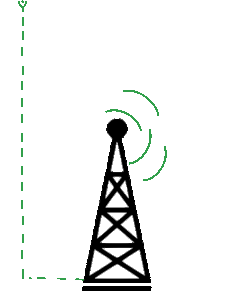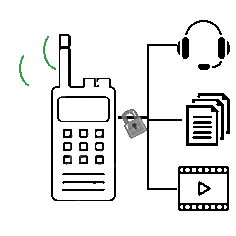DMR - Digital Mobile Radio for Critical Communication
DMR is a digital standard defined by ETSI. DMR uses a time division multiple access (TDMA) scheme while keeping the 12,5 kHz frequency spacing from analog radio times. This makes migration from an analog system to a DMR system quite smooth and easy. Most DMR terminals do also support analog conventional radio and can therefore be easily integrated into existing analog infrastructure before migration.


DMR is a radio service with different modes and many dialects
DMR does offer services in three so called tier levels. Tier 1 is radio to radio communication only. Tier 2 is a repeater mode, where one timeslot is reserved for a dedicated communication channel. Tier 3 does enable the so called trunking functionality. For critical communication the trunking solution is the most frequently used one, since it is standardised, interoperable between vendor brands and the most frequency economic approach. DMR Tier 3 does also come with quite many security features like encryption, authentication, emergency calls and position reports similar as TETRA.
There are also several proprietary trunking solutions per manufacturer available, not really fitting into Tier 2 or Tier 3 box. These solutions are somewhere in between and do only work, if infrastructure and terminals as well as applications from the same manufacturer are being used. Also within Tier 3 IOP test do suffer compared to TETRA slightly from the by far more slim specification compared to TETRA. Test cases are more limited, but standard communication will work across brands. Test results can be fulfilled in several languages, either a common language, or language of brand A or language of brand B. The tests do unfortunately not allow the conclusion if A is compatible with B and B is compatible to C, that A and C are compatible as well.
Benefits and Features
A large benefit of DMR is typically the costs of terminals and infrastructure compared to a TETRA or MCx solution. DMR systems are available across all low licensed frequency ranges from VHF to UHF (160MHz, 400MHz, 800MHz). Typically DMR frequencies are easier to license than TETRA frequencies, since they fit into the analog frequency rollout pattern with the 12,5kHz spacing.
Similar to TETRA and even more the data rate throughput in DMR is very narrowband and hereby very limited. Status SDS (sort data services like SMS in mobile network) and position reports do work very well.
Typically today, each infrastructure vendor does offer a proprietary extension to the mobile networks like LTE to extend coverage to the smartphone world. There is a so called IWF (interworking function) specified by TCCA and ETSI which in future does enable both TETRA and DMR to interconnect via standard interface to LTE MCx network.
A great thing inside DMR is the definition of a common application GW across all brands, which makes third parties the development for applications like dispatchers or recording systems fairly easy. Anyhow typically the applications of the same brand as the infrastructure are typically holding a larger feature set and appear more powerful.
Use cases
Typical use cases for DMR installations are systems, where the coverage area is pretty wide and the amount of terminals is low. Examples are coverage along a pipeline or along an energy supply grid. DMR is also used in train installations, mainly for voice communication. Data rate throughput within DMR is sufficient for SCADA (Supervisory Control And Data Acquisition) applications within the utility sector.
The security sector does use DMR terminals quite often within casinos, hotel resorts or sport and music events. Voice communication and position reports are the most needed features here.
The fact that DMR typically is not yet used as a nationwide public safety network across the globe, does provide a clue that the system size may reach a limit, as well as the available features do not work that smoothly in interoperability mode with other brands than other technologies like analog systems or TETRA systems do.
Anyhow DMR systems are the most installed systems and also the most sold radio terminals globally year by year over the last 5 and more years. Looking at the installed base only analog systems are deployed more often, but this only applies because of legacy reasons.
DMR alternatives - mind the difference
There is another standard available on the market, so called dPMR, basically initiated from the Asian market. The standard is also published from ETSI in Europe under ETSI TS 102 658. Be aware these technologies are not compatible. While DMR is using time multiplexing (TDMA), dPMR is using frequency multiplexing (FDMA).
